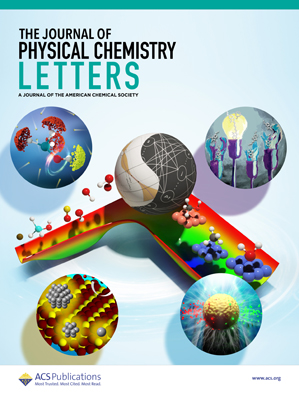通过前沿分子轨道工程增强二维金属有机框架的磁有序性
IF 4.6
2区 化学
Q2 CHEMISTRY, PHYSICAL
引用次数: 0
摘要
与无机固体或分子磁体相比,二维(2D)金属有机框架(MOFs)有望用于轻质永磁体,但由于自旋交换相互作用通常较弱,实现具有高有序温度的二维 MOF 磁体受到了限制。在此,我们提出了一种用于调节二维 MOF 磁性的前沿分子轨道工程策略。它表明,磁性基态可以由有机配体中的两种原子内自旋交换途径介导,类似于布洛赫模型和海森堡模型,这取决于有机配体前沿轨道的形状。通过化学氢化对最低未占分子轨道(LUMO)的形状进行设计,我们实现了有序温度近 11 倍的提高。特别是,定量分析显示,有序温度与配体 LUMO 的轨道涣散指数呈线性增长。这项研究提出了一种调节二维 MOF 磁体自旋交换相互作用的通用前沿轨道工程方法。本文章由计算机程序翻译,如有差异,请以英文原文为准。

Enhancing Magnetic Ordering in Two-Dimensional Metal–Organic Frameworks via Frontier Molecular Orbital Engineering
Two-dimensional (2D) metal–organic frameworks (MOFs) have promise for use in lightweight permanent magnets in contrast to inorganic solid- or molecule-based magnets, but the realization of 2D MOF magnets with a high ordering temperature is limited by the typically weak spin exchange interactions. Here, we have proposed a frontier molecular orbital engineering strategy for modulating magnetism in 2D MOFs. It shows that the magnetic ground state can be mediated by two intra-atomic spin exchange pathways in organic ligands, akin to the Bloch and Heisenberg models, depending on the shape of the frontier orbitals of the organic ligands. By engineering the shape of the lowest unoccupied molecular orbital (LUMO) via chemical hydrogenation, we achieved a nearly 11-fold increase in the ordering temperature. In particular, a quantitative analysis shows that the ordering temperature increases linearly with the orbital delocalization index of the ligands’ LUMO. This work suggests a general frontier orbital engineering approach for modulating the spin exchange interaction in 2D MOF magnets.
求助全文
通过发布文献求助,成功后即可免费获取论文全文。
去求助
来源期刊

The Journal of Physical Chemistry Letters
CHEMISTRY, PHYSICAL-NANOSCIENCE & NANOTECHNOLOGY
CiteScore
9.60
自引率
7.00%
发文量
1519
审稿时长
1.6 months
期刊介绍:
The Journal of Physical Chemistry (JPC) Letters is devoted to reporting new and original experimental and theoretical basic research of interest to physical chemists, biophysical chemists, chemical physicists, physicists, material scientists, and engineers. An important criterion for acceptance is that the paper reports a significant scientific advance and/or physical insight such that rapid publication is essential. Two issues of JPC Letters are published each month.
 求助内容:
求助内容: 应助结果提醒方式:
应助结果提醒方式:


